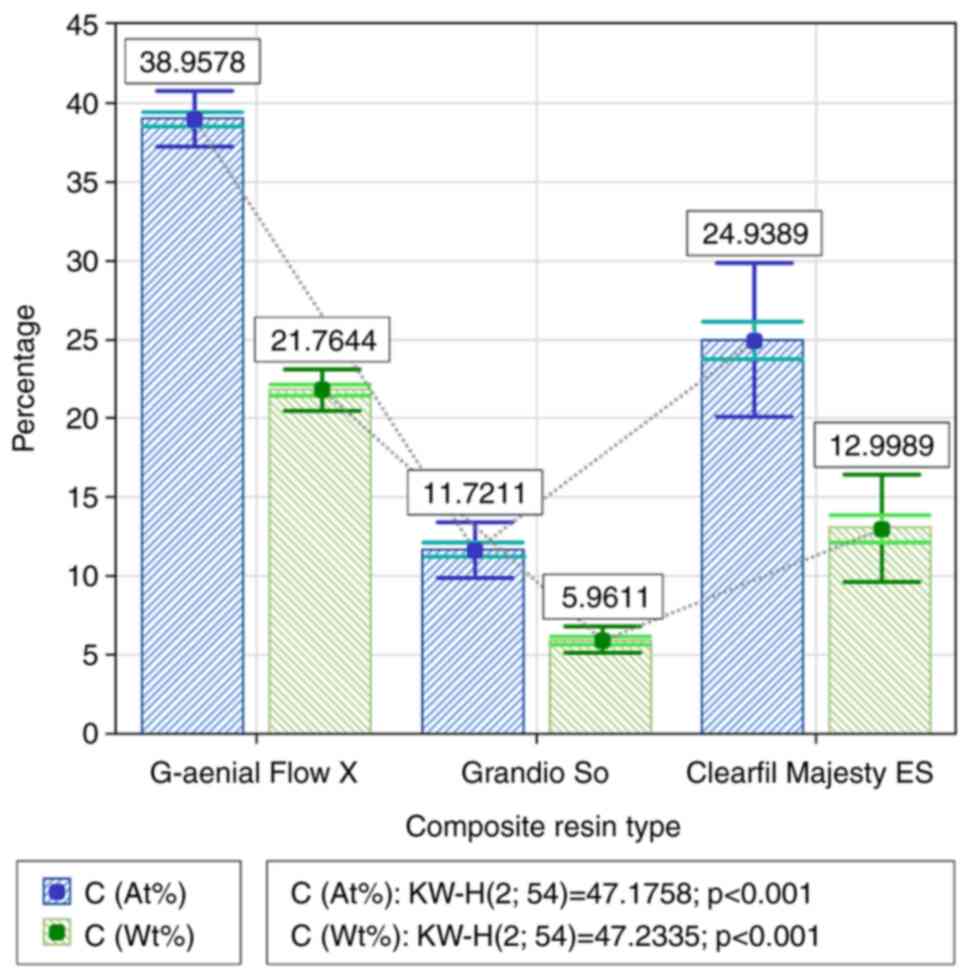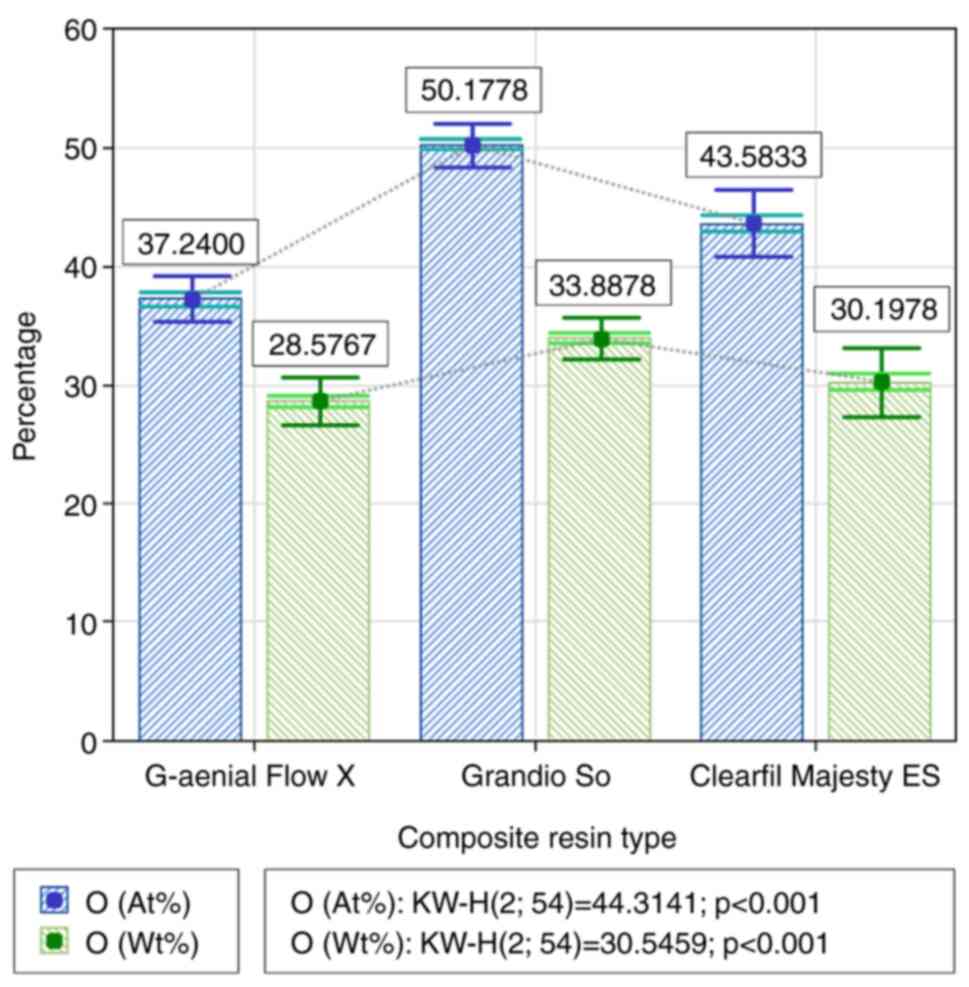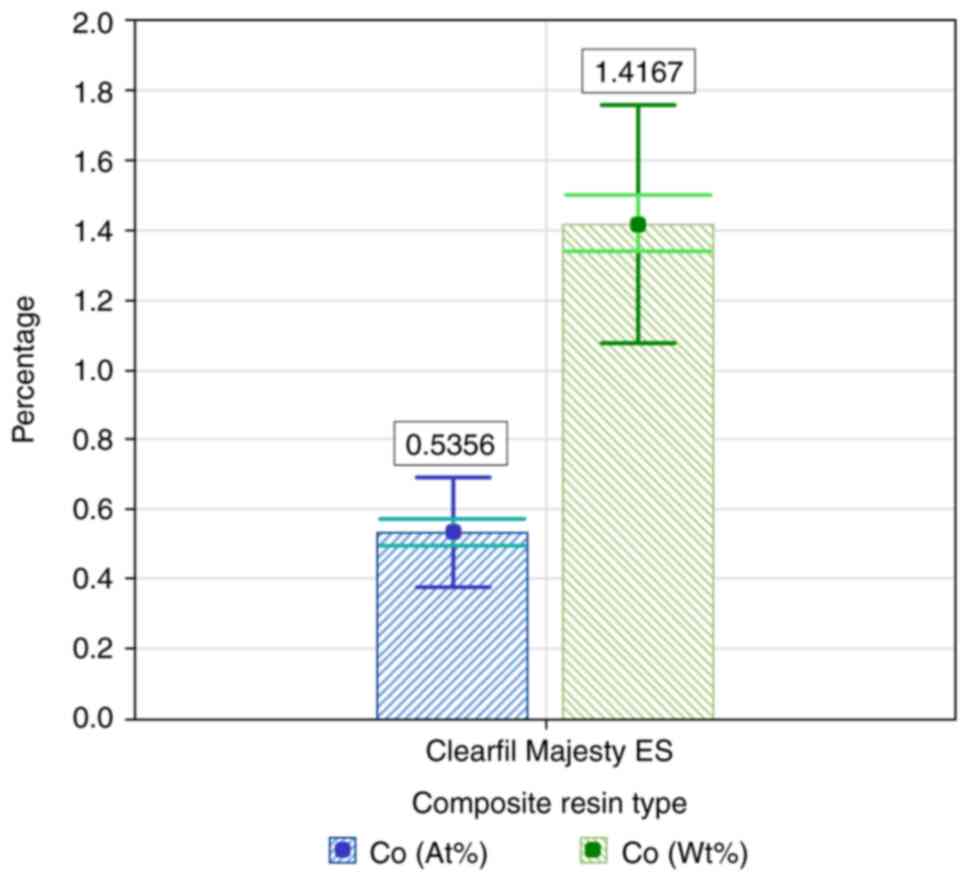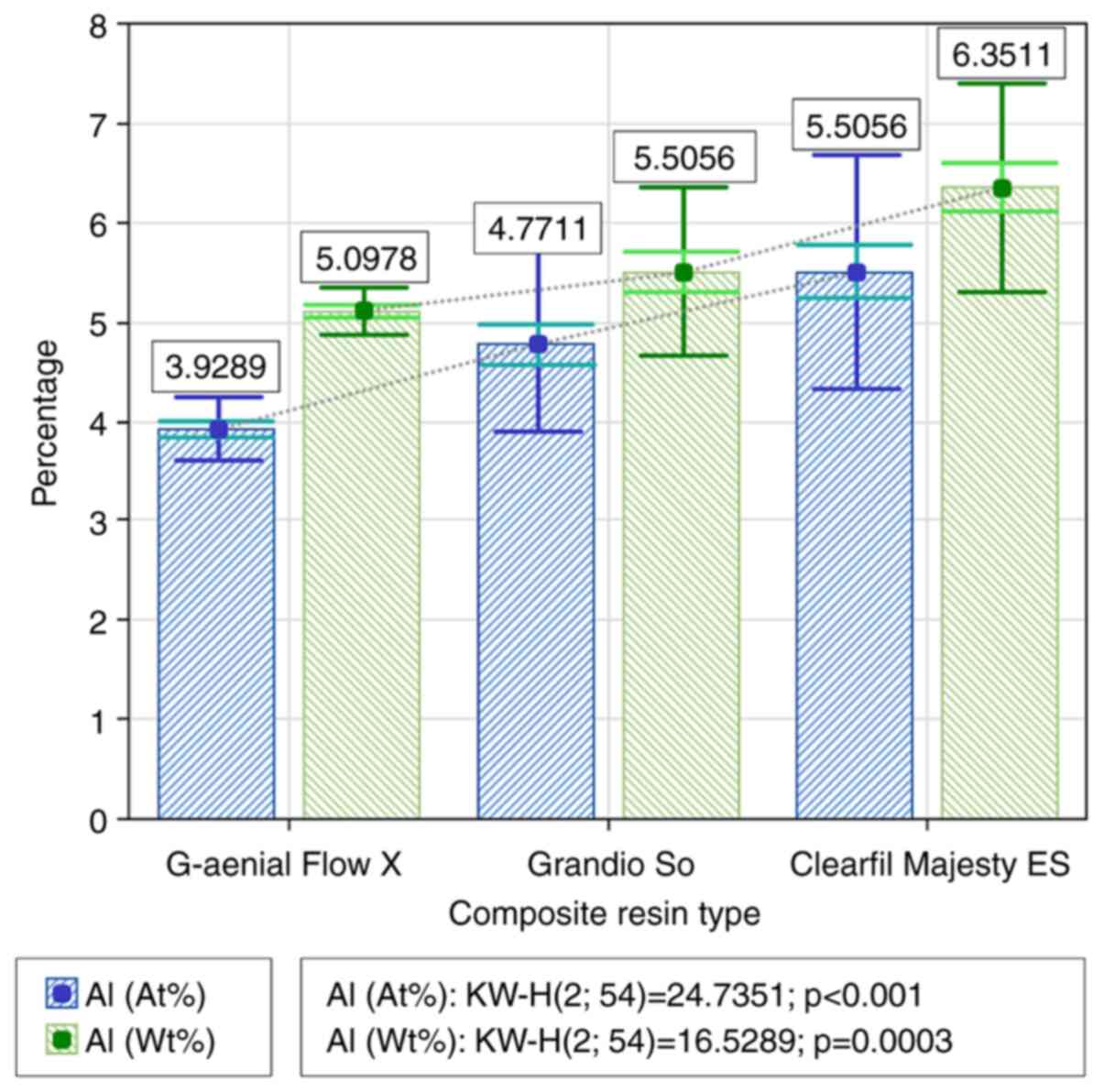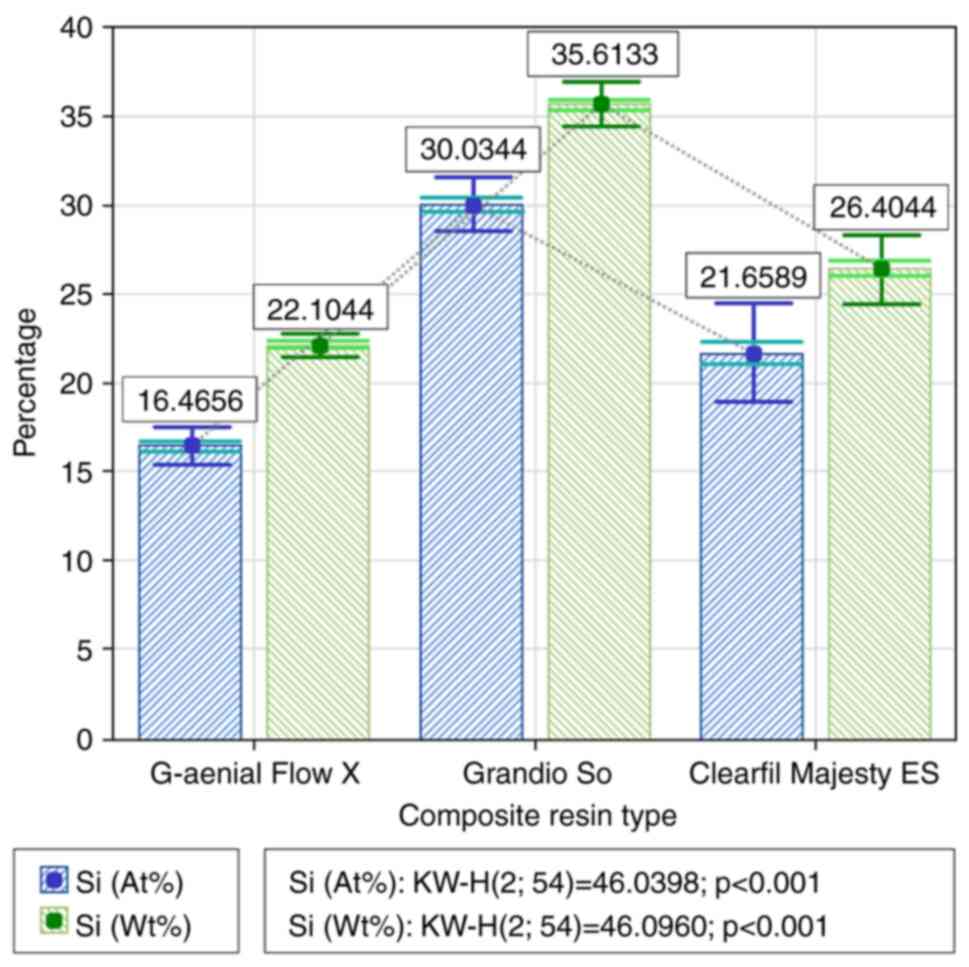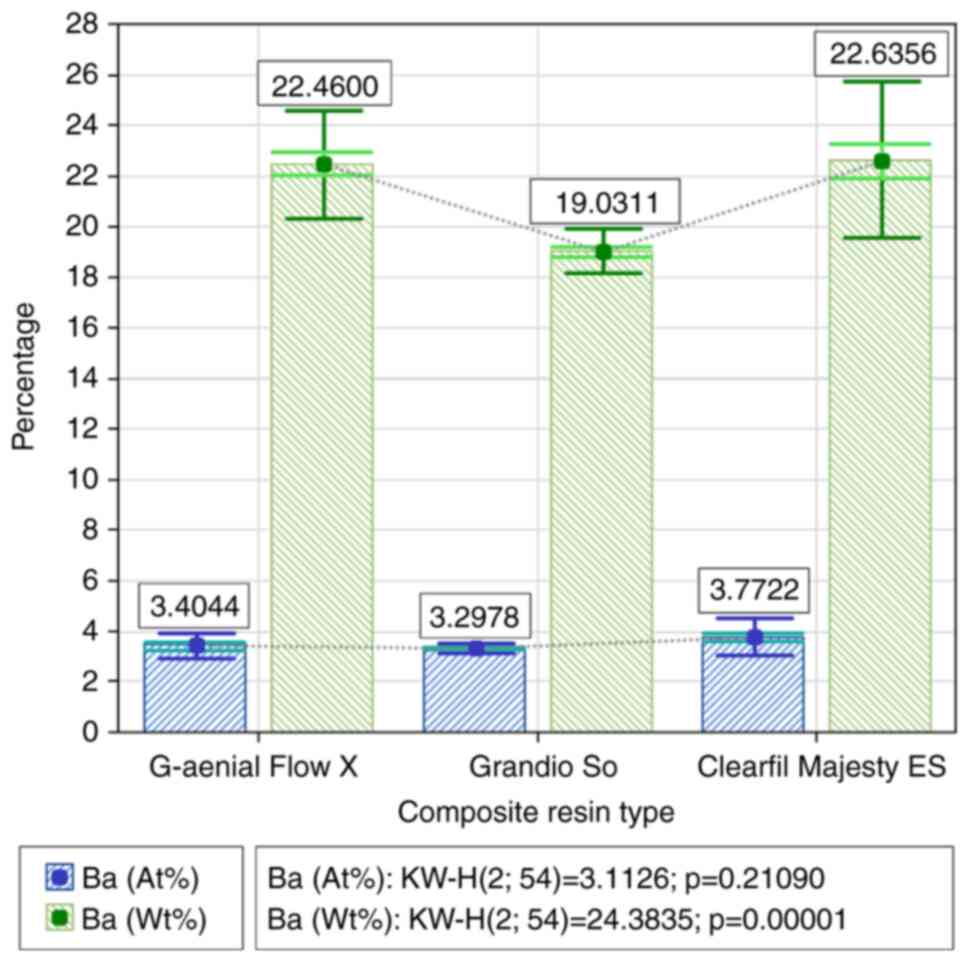Introduction
Periodontal disease is a term that includes a wide
range of inflammatory diseases that affect the periodontium, an
entity that consists of a set of structures that support the tooth,
gingiva, cementum, periodontal ligament and alveolar bone. Thus,
any damage to adjacent tissues can lead to increased tooth mobility
over time (1).
Physiological or normal dental mobility can be
defined as a slight displacement of the clinical dental crown, due
to the application of a moderate force, the displacement being
allowed by the resilience of a healthy and intact periodontium.
Findings of previous studies conducted primarily on
animals showed that the main cause of dental mobility is the laxity
of periodontal ligaments and/or the destruction of supporting
periodontal tissue, resulting from the presence of active or
treated periodontitis, whether or not combined with occlusal trauma
(2). In addition, occlusal forces
play an important role, as they can exacerbate a pre-existing
periodontal injury when they exceed the strength threshold of a
compromised supporting tissue (3).
In practice, it is accepted that dental splinting,
especially of the lower central incisors, is performed in order to
maintain the patient's natural dentition for a longer period, as
well as to reduce the patient's discomfort and improve the
masticatory and aesthetic functions (4). The factors influencing the success and
longevity of dental splinting are the type of material used for the
splint, the type of composite resin, and the number and location of
the dental units included for splinting (maxillary or mandibular
arch) (5).
In periodontology, the term ‘splint’ is defined as
the joining of two or more teeth into a rigid unit through
restorations or fixed or removable devices. The purpose of using
periodontal splints is to provide a period of rest in the areas
where the healing process has begun (to reduce stress on the
affected teeth) and to allow normal functioning where the tissues
alone would not be able to withstand occlusal forces (6). Currently, many types of splints for
immobilization are available, their diversity depending on their
purpose and duration of use, the position of the teeth on the
mandible, but also of the manufacturing material. Various materials
have been used for splints, such as composite resin in combination
with adhesive systems, orthodontic systems or composites reinforced
with pre-impregnated fibers in combination with composite resins.
An important aspect for selecting the type of splint is the
mechanical interaction between the material from which the splint
is made and the underlayment of the tooth (6). Fluid composites are low-viscosity
composites, and this makes them more fluid than universal
composites, with high tooth humectability and low elasticity
(6).
The aim of the present study was to evaluate
comparatively, by means of energy dispersive electron spectrometry
(EDX), the chemical composition in the case of in vitro
samples that structurally reproduce direct periodontal
immobilization systems using fiberglass strips and fluid composite
resins.
Materials and methods
Materials
In order to achieve the proposed aim, 54 samples of
teeth were selected with the following dimensions: 15 mm in length,
4 mm in width and 2.5 mm in thickness, using a heat-resistant
silicone conformer.
For the construction of the immobilization systems,
the same fiberglass tape, Interlig®
(Angelus®, Brazil) and three different fluid composites
were used: G-aenial Flo X® (GC Corporation®,
Japan), GrandioSO Heavy Flow® (Voco®,
Germany) and Clearfil Majesty ES Flow® (Kuraray Noritake
Dental®, Japan). The number of samples produced and
later subject to elemental investigation was equal, namely 18 for
each composite resin. The photopolymerization of the samples was
carried out using a Celalux 2® type lamp (Voco).
Subsequently, all 54 periodontal splint samples were
grouped, and their microstructure was analyzed using a Quanta 200
3D scanning electron microscope (FEI, The Netherlands) in the
laboratory of the Faculty of Mechanics from the ‘Gheorghe Asachi’
Technical University of Iasi, Romania.
EDX spectrometer
The EDX spectrometer is an instrument that
determines quantitatively the elements in a sample by irradiating
it with X-rays and then analyzing the re-emitted X-rays. It
represents a standard method to identify and quantify element
compositions of very small samples of material (even a few cubic
micrometers). The EDX elemental analysis was performed for each
type of composite separately, G-aenial Flo X (GC Corp.), GrandioSO
Heavy Flow (Voco) and Clearfil Majesty ES Flow (Kuraray), in three
different areas of each sample.
The data were automatically corrected for atomic
number, absorption and fluorescent excitation effects using the ZAF
correction method for each investigated element. Following the
investigations, we analyzed, for each element, both the mass
percentage (wt%) and the atomic percentage (at%).
Statistical analysis
The statistical analysis was performed using SPSS
25.0 (IBM Corp.) The Kolmogorov-Smirnov test was used to test the
distribution of the numerical variables. The average value, the
standard error and the standard deviation of the numerical
variables were calculated. The Kruskal-Wallis and Mann-Whitney
non-parametric tests were used to compare the variables with
non-normal distributions. P<0.05 was considered to indicate
statistically significant results.
Results
Carbon (C) content
The values found for carbon were significantly
different between the three types of materials, in the case of both
measurements, both globally and comparatively between materials two
by two. For example, for wt% determinations, the highest C content
was recorded for G-aenial Flo X (21.7644±1.32468) and the lowest
for GrandioSO Heavy Flow (5.9611±0.87104); the C content for
Clearfil Majesty ES being intermediate (12.9989±3.44164). However,
the differences between the three materials were statistically
significant in all combinations. A similar behavior was observed in
the case of at% determinations (Fig.
1).
Oxygen (O) content
The O content was also significantly different
between the three types of materials, in both measurements, both
globally and comparatively between materials two by two. In the
case of the wt% measurement, the highest O content was observed for
GrandioSO Heavy Flow (33.878±1.74974), followed by Clearfil Majesty
ES (30.1978±2.91155), and lastly by G-aenial Flo X
(28.5767±2.05314). The observed differences were considered
statistically significant (Table
I). The same results were observed in the case of at%
measurements (Fig. 2).
 | Table IStatistical analysis of the mass (wt%)
and atomic percentage (at%) for all analyzed elements in the three
types of materials. |
Table I
Statistical analysis of the mass (wt%)
and atomic percentage (at%) for all analyzed elements in the three
types of materials.
| | Mann-Whitney test (2
samples) P-value |
|---|
| Mass and atomic
percentage of the elements | Kruskal-Wallis test
(3 samples) P-value | G-aenial Flo X vs.
Grandio SO Heavy Flow | G-aenial Flo X vs.
Clearfil Majesty ES | Grandio SO Heavy Flow
vs. Clearfil Majesty ES |
|---|
| C (wt%) |
<0.001b |
<0.001b |
<0.001b |
<0.001b |
| C (at%) |
<0.001b |
<0.001b |
<0.001b |
<0.001b |
| O (wt%) |
<0.001b |
<0.001b | 0.037a |
<0.001b |
| O (at%) |
<0.001b |
<0.001b |
<0.001b |
<0.001b |
| Al (wt%) |
<0.001b | <0.104 |
<0.001b | 0.027a |
| Al (at%) |
<0.001b |
<0.001b |
<0.001b | 0.293 |
| Si (wt%) |
<0.001b |
<0.001b |
<0.001b |
<0.001b |
| Si (at%) |
<0.001b |
<0.001b |
<0.001b |
<0.001b |
| Ba (wt%) |
<0.001b |
<0.001b | 0.864 |
<0.001b |
| Ba (at%) | 0.211 | 0.719 | 0.293 | 0.068 |
Cobalt (Co) content
The average Co content was observed only for the
Clearfil Majesty ES material, being 1.4167±0.33941 in the case of
the wt% measurement and 0.5356±0.15523 in the case of the at%
measurement, respectively (Fig.
3).
Aluminum (Al) content
The Al content was also significantly different
between the three types of materials, in both measurements, but
only globally. In the case of the wt% measurement, the highest Al
content was observed for Clearfil Majesty ES (6.3511±1.04642),
followed by Grandio So (5.5056±0.83701) and lastly, by G-aenial Flo
X (5.0978±0.26932). The Al content of Clearfil Majesty ES was
statistically significantly higher than that of the other two
materials tested; however, the differences between the latter two
(G-aenial Flo X and Grandio So) were small and had no statistical
significance (Fig. 4). A similar
behavior was observed in the case of at% measurements, except that
in this case the difference between Clearfil Majesty ES and Grandio
So was smaller, not statistically significant, while other
differences between varying combinations of materials were
important and statistically significant (Table I).
Silicium (Si) content
The Si content was also significantly different
between the three types of materials, in the case of both
measurements, both globally and comparatively between materials,
two by two. In the case of the wt% measurement, the highest Si
content was observed again for GrandioSo Heavy flow
(35.6133±1.23026), followed by Clearfil Majesty ES
(26.4044±1.93859) and lastly, by G-aenial Flo X (22.1044±0.64334),
the observed differences being large enough to be statistically
significant. The same phenomenon was observed in the case of at%
measurements (Fig. 5).
Barium (Ba) content
The Ba content was significantly different between
the three types of materials, but only globally and only in the
case of the wt% measurement. In the case of the wt% measurement,
the highest Ba content was observed for Clearfil Majesty ES
(22.6356±3.09334), followed by G-aenial Flo X (22.4600±2.11290) at
a very small difference and without statistical significance and,
at a difference that was higher and with low statistical
significance, by Grandio So (19.0311±0.92871) (Table I). The order of the three materials
was the same in the case of at% measurements in terms of Ba
content, only in this case the recorded values were close to each
other, without statistically significant differences between the
analyzed materials (Fig. 6).
Discussion
The composition of composite resins is complex and
from the perspective of energy dispersive electron spectrometry
(EDX) analysis, general information was obtained regarding the
structural elements of resins (7).
Elements such as C, O, Al, Si and Ba were identified as common
elements among the resins tested in the present study. The only
difference in terms of the component elements was found in the case
of the fluid composite Clearfil Majesty ES flow, which, apart from
the elements mentioned, also presented Co in its structure.
Clearfil Majesty ES flow is a light-curable,
radio-opaque composite resin containing nanoparticles and a high
refraction matrix (8). It has a
light diffusion property very similar to the structure of natural
teeth, which makes it versatile for almost any situation in which a
composite must be used. The high refraction matrix also offers
another key benefit: a very small change in transparency after
photopolymerization/light curing (9).
GrandioSO Heavy Flow is a nanohybrid composite with
high viscosity which, due to its high filling rate, has exceptional
physical properties including stability, compressive strength,
adaptability, and flexural strength. It is capable of withstanding
abrasion, shrinkage, wear and polishing, thus giving the dentist
many solutions to the challenges posed by practice. With an initial
shrinkage of less than 3% and flexural strength above 400 MPa,
GrandioSO Heavy Flow creates varied opportunities for use compared
to other flow composites. Compared to the other composites used in
the present study, G-aenial Flo X is a composite with high strength
and radio-opacity, specially designed for optimal handling in
microcavities and cracks.
There are two basic properties by which fibers can
increase the effectiveness of a composite resin. Fibers act as a
stress-bearing component. This enhances the otherwise brittle
effect of the composite matrix. Secondly, fibers have a
fracture-arresting property or a crack deflection mechanism, which
in turn increases the strength of the material. It is important for
the clinician to manufacture a system able to withstand all failure
mechanisms in the most favorable manner possible. All these
mechanisms depend on the direction in which the stress is applied
to the device (10).
Fiberglass-reinforced composite resins are a type of
material that combine a polymeric matrix and reinforcing fibers.
When pressure is applied to the material, the intervening fibers
are the composite fibers, which lend the material strength and
hardness. The reinforced fibers can be unidirectional continuous
(rovings), bidirectional continuous (weaves), randomly oriented
continuous (matte) or they can be discontinuous and randomly
oriented (11).
Currently, many materials are used for a dental
immobilization system, including metal wires or fiber-reinforced
composites. In the medical field, composite materials are used more
often because they are chemically stable and do not induce negative
effects, as the human body tolerates them easily. The most widely
used materials today for making fiber-reinforced composite resin
systems are glass and polyethylene fibers. The fibers have been
developed in order to be able to strengthen the dental composite
resins, thus forming strong, but thin structures (12). Based on the results of their study,
Juloski et al concluded that the reinforcement of fibers
with fluid composite does not affect the shear strength of the
enamel, and that the flexural strength of the fibers is
significantly influenced by their composition and model (13).
An important factor in the success of periodontal
splinting is the biomechanical behavior of these systems on dental
units. The type and material of the immobilization system also play
an important role in the success of the treatment. There are
differences between composites reinforced with polyethylene fibers
and those made of metal wires. Thus, the stresses on the bone in
the case of incisors were higher in the polyethylene fiber tapes
compared to those containing metal wires, this being attributed to
the more elastic behavior of the polyethylene fibers. When the
force was applied to the canines, higher stresses were identified
in the case of metal immobilization systems (14).
The capacity of the material used must be evaluated
primarily according to the durability and efficiency it offers.
These two characteristics are also influenced by the consistency of
the composite material used. Other findings on the influence of
composite resins on the success rate of periodontal immobilization
have concluded that high viscosity flow composite resins showed the
best treatment success rate (15).
Compared to these, solid composites showed an acceptable success
rate, the failures being closely related to the consequences of
difficult handling of this type of material on the lingual face of
the teeth. At the opposite end, avoidance of classical flow
composites in periodontal immobilization is recommended, since
their mechanical strength is not sufficient for the stress to which
they are subjected (16).
The differences in the chemical composition of the
investigated materials can influence their physiochemical
properties, but also their biological and toxicological
reliability. Local and systemic toxic effects of dental materials
can appear if these materials are placed in the oral cavity for a
long period of time (17). The
general opinion of the scientific community is that no material can
be 100% safe biologically, and that most adverse effects of
materials are mediated by substances released from the material
during corrosion (18).
In vitro studies performed on cultured mouse
fibroblasts revealed changes in the growth and morphology of cells
exposed to cobalt. Co exposure was found to be associated with the
depression of the cell growth rate, concluding that increased
concentrations of cobalt could affect the normal reconstructive
activity of fibroblasts (19).
However, significant health effects (neurological, cardiovascular
and endocrine deficits) are unlikely to occur at blood Co
concentrations under 300 µg/l in healthy individuals, and chronic
exposure to acceptable doses is not expected to pose considerable
health hazards (20).
Although a higher percentage of aluminum present in
the material is associated with low material density, good
malleability and good ductility, it is important to take into
account the fact that aluminum is a toxic metal, and its release in
high quantities can lead to unwanted adverse effects (pro-oxidant,
inflammagen, immunogen), which is involved in human
neurodegenerative diseases (21).
However, Meryon and Jakeman investigated the release of aluminum
from several materials and its in vitro toxicity towards
culture cells, but the aluminum concentrations released in the
medium did not exceed 15 ppm, while levels of 40 ppm were usually
associated with toxic effects on fibroblasts and macrophages
(22).
Based on various property measurements,
silica-filled cured composites showed highly desirable
comprehensive performances including dielectric, breakdown,
mechanical, thermal and mass stability properties. Thus, low
permittivity, low dielectric loss, high electric breakdown
strength, high ageing breakdown strength, high shock strength, high
thermal conductivity and low weight loss percentage were obtained
in micro-silica loaded composites, leading to their promising
application in electrical insulation cases. The large band gap and
relatively high deformation ability of silica particles could
contribute to favorable breakdown and mechanical properties of
composites. Silica-filled cured composites exhibited a breakdown
strength of ca. 48 MV m-1 and shock strength of ca. 9950
J m-2. This study may open the door towards the
large-scale manufacture of high-performance epoxy composite
potting-adhesives (23).
To enhance the penetration of dental adhesives, the
enhancement of hydrophilicity and homogeneity of adhesive formula
is the most commonly used strategy.
Silica fillers are hydrophilic, so there is a
restriction in their affinity to hydrophobic resins. Through
surface treatment with silane-coupling agents, the mixing of
hydrophilic silica filler and the interaction between filler and
organic components could be improved. Kim et al hypothesized
that an increased hydrophilicity of the fillers can increase the
even dispersion within the adhesive layer under moist conditions,
thus increasing the bond strength (24).
Carefully modified handling property is helpful in
producing a uniform adhesive layer at a feasible thickness, thus
leading to a satisfactory bonding performance. In addition to
texture, viscosity is an important parameter in evaluating the
handling properties of dental adhesives (25).
Bonding performance is one of the most important
aspects for the evaluation of dental adhesives. High-bond strength
of the adhesion joint is always an aim in the development of dental
adhesives.
In the current study, the highest amount of Si was
identified in the samples produced using GrandioSO Heavy flow,
which suggests a higher biomechanical strength of this product by
comparison with the other samples included in the study. The
presence of cobalt was identified only in the samples of Clearfil
Majesty ES Flow and from the point of view of our results is
irrelevant to the oral toxicity. The issue of metal ions release
over time in the oral medium must be taken into account and
evaluated frequently. The acid environment in the mouth leads to
erosion, and cobalt release from dental materials has been
associated with allergic reactions (26,27).
The statistically significantly higher amount of
aluminum was determined in the samples made using the Clearfil
Majesty ES composite resin, which can thus be associated with low
material density, good malleability and good ductility.
The high amount of carbon identified in the samples
that involved the use of G-aenial Flo X may indicate a slightly
higher abrasive potential of the material in the clinical
context.
Although the materials included in the present study
can be successfully used for periodontal splinting, their behavior
towards the adjacent tissues should also be evaluated. For this
reason, the future research direction could assess the cytotoxicity
of these materials and potentially establish a link between the
presence of certain chemical elements, material strength and
biocompatibility.
Thus, further studies are necessary and must be
focused on the biological compatibility of the composite resins
used for periodontal splinting in order to minimize the
toxicological hazards at the level of oral tissues.
Acknowledgements
Professional editing, linguistic and technical
assistance performed by Irina Radu, Individual Service
Provider.
Funding
No funding was received.
Availability of data and materials
The data used and/or analyzed during the current
study are available from the corresponding authors on reasonable
request.
Authors' contributions
AG, AJ, IM, SMS, LF, MT and IL designed the study
and interpreted the data. IL supervised and coordinated the
research project. AG, AJ and IL wrote the main manuscript. BI made
the experimental determinations. CGD, IȚ, AM and DCKN contributed
to the data analysis and data interpretation and edited the final
form of the manuscript. All authors read and approved the final
manuscript for publication. AG, BI and IL confirm the authenticity
of all the data.
Ethics approval and consent to
participate
Not applicable.
Patient consent for publication
Not applicable.
Competing interests
The authors declare that they have no competing
interests, and none of the authors have any affiliations with GC
Corporation, Voco and Kuraray Noritake Dental.
References
|
1
|
Cardoso EM, Reis C and Manzanares-Céspedes
MC: Chronic periodontitis, inflammatory cytokines, and
interrelationship with other chronic diseases. Postgrad Med.
130:98–104. 2018.PubMed/NCBI View Article : Google Scholar
|
|
2
|
Giannakoura A, Pepelassi E, Kotsovilis S,
Nikolopoulos G and Vrotsos I: Tooth mobility parameters in chronic
periodontitis patients prior to periodontal therapy: A
cross-sectional study. Dent Oral Craniofac Res. 5:1–8. 2019.
|
|
3
|
Soares PB, Fernandes Neto AJ, Magalhães D,
Versluis A and Soares CJ: Effect of bone loss simulation and
periodontal splinting on bone strain: Periodontal splints and bone
strain. Arch Oral Biol. 56:1373–1381. 2011.PubMed/NCBI View Article : Google Scholar
|
|
4
|
Kathariya R, Devanoorkar A, Golani R,
Shetty N, Vallakatla V and Bhat MY: To splint or not to splint: The
current status of periodontal splinting. J Int Acad Periodontol.
18:45–56. 2016.PubMed/NCBI
|
|
5
|
Littlewood SJ, Millett DC, Doubleday B,
Bearn DR and Worthington HV: Orthodontic retention: A systematic
review. J Orthod. 33:205–212. 2006.PubMed/NCBI View Article : Google Scholar
|
|
6
|
Liu X, Zhang Y, Zhou Z and Ma S:
Retrospective study of combined splinting restorations in the
aesthetic zone of periodontal patients. Br Dent J. 220:241–247.
2016.PubMed/NCBI View Article : Google Scholar
|
|
7
|
Vilchis RJ, Hotta Y and Yamamoto K:
Examination of six orthodontic adhesives with electron microscopy,
hardness tester and energy dispersive X-ray microanalyzer. Angle
Orthod. 78:655–661. 2008.PubMed/NCBI View Article : Google Scholar
|
|
8
|
Scougall-Vilchis RJ, Hotta M, Hotta M,
Idono T and Yamamoto K: Examination of composite resins with
electron microscopy, microhardness tester and energy dispersive
X-ray microanalyzer. Dent Mater J. 28:102–112. 2009.PubMed/NCBI View Article : Google Scholar
|
|
9
|
Karadas M: The effect of different
beverages on the color and translucency of flowable composites.
Scanning. 38:701–709. 2016.PubMed/NCBI View Article : Google Scholar
|
|
10
|
Özcan M and Kumbuloglu O: Periodontal and
trauma splints using fiber reinforced resin composites. In:
Clinical Guide to Principles of Fiber-Reinforced Composites in
Dentistry. 1st edition. Woodhead Publishing, pp111-130, 2017.
|
|
11
|
Vallittu PK: An overview of development
and status of fiber-reinforced composites as dental and medical
biomaterials. Acta Biomater Odontol Scand. 4:44–55. 2018.PubMed/NCBI View Article : Google Scholar
|
|
12
|
Bechir ES, Pacurar M, Hantoiu TA, Bechir
A, Smatrea O, Burcea A, Gioga C and Monea M: Aspects in
effectiveness of glass- and polyethylene-fibre reinforced composite
resin in periodontal splinting. Mater Plast. 53:104–109. 2016.
|
|
13
|
Juloski J, Beloica M, Goracci C, Chieffi
N, Giovannetti A, Vichif A, Vulicevic ZR and Ferrari M: Shear bond
strength to enamel and flexural strength of different
fiber-reinforced composites. J Adhes Dent. 15:123–130.
2013.PubMed/NCBI View Article : Google Scholar
|
|
14
|
Vieriu RM, Tanculescu O, Mocanu F, Solomon
SM, Savin C, Bosinceanu DG, Doloca A, Iordache C, Ifteni G and
Saveanu I: In vitro study regarding the biomechanical behaviour of
bone, fibre reinforced polymer and wire composite perio-dontal
splints. II. model analysis. Mater Plast. 57:253–262. 2020.
|
|
15
|
Luchian I, Nanu S, Martu I, Teodorescu C,
Pasarin L, Solomon S, Martu MA, Tatarciuc M and Martu S: The
influence of highly viscous flowable composite resins on the
survival rate of periodontal splints. Rom J Oral Rehabilitation.
10:63–69. 2018.
|
|
16
|
Luchian I, Nanu S, Martu I, Martu MA,
Nichitean G, Nitescu DC, Gurau C, Victorita S, Pasarin L, Tatarciuc
M and Solomon SM: The influence of the composite resin material on
the clinical working time in fiberglass reinforced periodontal
splints. Mater Plast. 57:316–320. 2020.
|
|
17
|
Shahi S, Özcan M, Maleki Dizaj S, Sharifi
S, Al-Haj Husain N, Eftekhari A and Ahmadian E: A review on
potential toxicity of dental material and screening their
biocompatibility. Toxicol Mech Methods. 29:368–377. 2019.PubMed/NCBI View Article : Google Scholar
|
|
18
|
Wataha JC: Predicting clinical biological
responses to dental materials. Dent Mater. 28:23–40.
2012.PubMed/NCBI View Article : Google Scholar
|
|
19
|
Polyzois GL: In vitro evaluation of dental
materials. Clin Mater. 16:21–60. 1994.PubMed/NCBI View Article : Google Scholar
|
|
20
|
Leyssens L, Vinck B, Van Der Straeten C,
Wuyts F and Maes L: Cobalt toxicity in humans-A review of the
potential sources and systemic health effects. Toxicology.
387:43–56. 2017.PubMed/NCBI View Article : Google Scholar
|
|
21
|
Exley C: Human exposure to aluminium.
Environ Sci Process Impacts. 15:1807–1816. 2013.PubMed/NCBI View Article : Google Scholar
|
|
22
|
Meryon S and Jakeman J: Aluminium and
dental materials-a study in vitro of its potential release and
toxicity. Int Endod J. 20:16–19. 1987.PubMed/NCBI View Article : Google Scholar
|
|
23
|
Hu JB: High-performance ceramic/epoxy
composite adhesives enabled by rational ceramic bandgaps. Sci Rep.
10(484)2020.PubMed/NCBI View Article : Google Scholar
|
|
24
|
Kim IJ, Kim D, Ahn B, Lee HJ, Kim HJ and
Kim W: Vulcanizate structures of SBR compounds with silica and
carbon black binary filler systems at different curing
temperatures. Polymers (Basel). 12(2343)2020.PubMed/NCBI View Article : Google Scholar
|
|
25
|
Wang J, Yu Q and Yang Z: Effect of
hydrophobic surface treated fumed silica fillers on a one-bottle
etch and rinse model dental adhesive. J Mater Sci Mater Med.
29(10)2017.PubMed/NCBI View Article : Google Scholar
|
|
26
|
Kostić M, Pejcic A, Igić M and
Gligorijević N: Adverse reactions to denture resin materials. Eur
Rev Med Pharmacol Sci. 21:5298–5305. 2017.PubMed/NCBI View Article : Google Scholar
|
|
27
|
Bationo R, Ablassé R, Diarra A,
Beugré-Kouassi ML, Jordana F and Beugré JB: In vitro Assessment of
cytotoxicity of orthodontic and dental composite resins using human
gingival fibroblast. Sch J Dent Sci. 6:352–355. 2019.
|















